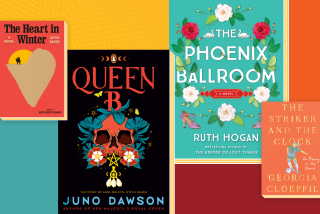Paging Daedalus
GREEK myths have long inspired storytellers, but it took author Rick Riordan to bring them roaring to life for the middle-school crowd with his action-packed, wisecracking âPercy Jackson and the Olympiansâ series.
It began with 2005âs âThe Lightning Thief,â in which 12-year-old Percy, a hyperactive New York boy with dyslexia who lives with a single mother, learns that his absent father is Poseidon, the Greek god of the sea. With deft touches, Riordan set the stage: The ancient gods are alive, scheming and siring demigod children with mere mortals. Mt. Olympus now looms above the Empire State Building and the Underworld sits below -- surprise! -- Los Angeles. Medusa, the Furies, the Laistrygonians (giant cannibals) and other monsters stalk the Earth, determined to kill the young demigods, who gather at Camp Half-Blood off Long Island Sound each summer to hone ancient martial arts.
âThe Battle of the Labyrinth,â the fourth in the series, is a glorious, no-holds-barred adventure with great plot twists, a melding of ancient and bionic technology and a cliffhanger ending that will have fans eagerly awaiting the fifth and final showdown between gods and monsters next year.
Riordanâs genius is in reimagining classic myths for the 21st century, making them relevant to young adult readers while staying true to the spirit of the originals. âBattle of the Labyrinthâ focuses on the sinister maze where Theseus slew the Minotaur. But the labyrinth isnât under a palace in Crete anymore; it lies just below the mortal world, where âitâs been growing for thousands of years, lacing its way under Western cities, connecting everything together underground.â
With its secret entrances, exits, dead ends, shifting paths and lurking monsters, the labyrinth is a death trap but also a potent weapon for anyone who can navigate it, especially demigod Luke Castellan, a son of Hermes who is trying to liberate Kronos, the Titan king whom the Olympians cut into tiny pieces and banished to Tartarus eons ago. When both sides discover that the labyrinthâs 2,000-year-old creator, Daedalus, is still alive and hiding in its center, the race is on to see who finds him first.
Itâs a classic quest, but Percy is no brooding, solitary Joseph Campbell-style hero. The now-14-year-old cutup descends into the labyrinth with his good friend and love interest Annabeth, the daughter of Athena; the satyr Grover, with whom Percy shares an âempathyâ link; and Percyâs half brother, Tyson, a bumbling but super-strong Cyclops.
With cameos by Theseus, Calypso, Icarus, King Minos and such mortals as Rachel Elizabeth Dare, a girl from an earlier volume who also stirs Percy and provides unexpected help, the book is filled with emotionally satisfying touches as well as urgency.
Riordan is adept at using fantasy tropes to further the plot. When Percy sleeps, he dreams about what his enemies are up to. The demigods send âIris-messagesâ by throwing gold drachmas through magic rainbows. And just when things get too tense, along comes Mrs. OâLeary, a gamboling giant hellhound, to provide comic relief.
Boys and girls alike love these books because theyâre packed with action and filled with appealing characters, including the savvy Annabeth, who calls Percy âseaweed brain.â But the demigodsâ concerns about friendship, romantic rivals and family also ring true, even if the parents they face arenât yours or mine but Ares, Hades and Zeus.
Parents and educators have embraced the series because its books are tricked-out Trojan horses: mythology masquerading as adventures involving not only the Olympians but also telekhines, dracaenae and the she-dragon Kampe (which may send adults running for their mythology texts).
The contemporary touches are hilarious. Nico di Angelo, a son of Hades who wants to resurrect his dead sister, tosses Coca-Cola and McDonaldâs Happy Meals into a bubbling pit to summon ghosts. (He obviously hasnât seen âSuper Size Meâ). The Sphinx has a TV game show called âAnswer That Riddleâ where losers get eaten.
And when Percy describes how he cleaned out Aegeasâ stable -- filled with 1,000 years of road apples from fire-breathing, flesh-eating horses -- his mother, channeling moms everywhere, observes: âI canât get him to clean his room, but heâll clean a hundred tons of horse manure out of some monsterâs stables?â
Riordan infuses everyday objects with magic. Annabethâs baseball cap confers invisibility. Percyâs pen turns into a 3-foot-long sword. Half-blood kids avoid mobile phones because they alert monsters to their whereabouts.
Riordan isnât the first to use Greek myths in childrenâs literature. But he may be the smoothest, streamlining the complex genealogies and explaining the finer points through action and dialogue. No long digressions or lectures slow down the tale.
Perhaps thatâs because Riordan started out as a mystery writer (heâs written eight adult novels in the âTres Navarreâ series and has won many awards, including the Mystery Writers of Americaâs Edgar.) He also taught middle school for 15 years.
Riordan wrote the first Percy Jackson tale as a fluke and has said he wasnât sure how it would be received. Now published in many languages, the books have sat on the New York Timesâ bestseller list for an entire year and the inevitable movie (from 20th Century Fox, with Chris Columbus directing), is in the works. One thing is sure: Whatever Riordan does next, heâll have an Olympian fan base. *
More to Read
The biggest entertainment stories
Get our big stories about Hollywood, film, television, music, arts, culture and more right in your inbox as soon as they publish.
You may occasionally receive promotional content from the Los Angeles Times.










